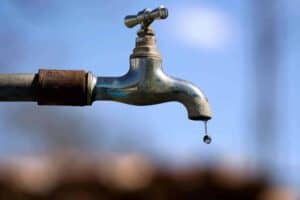Water reports highlight problems with infrastructure, policies, planning, and misappropriation of funds.

The Department of Water and Sanitation (DWS) on Tuesday revealed alarming information about the state of water and sanitation services in South Africa.
Concerns around the quality of water in the country have come to the fore after the recent cholera outbreak. So far, 26 deaths have been recorded, with around 130 active cases in five of South Africa’s nine provinces.
Given that cholera is a waterborne disease, it has raised doubts about the safety of water for human consumption.
ALSO READ: ‘Durban tap water not contaminated and safe to drink’ – Umgeni Water
Minister for the DWS Senzo Mchunu said that while the source of the cholera outbreak is yet to be determined, the fact remains that it is a bacterial disease usually spread through contaminated water.
“For that fact, we need to concern ourselves with ensuring that municipalities fulfill their obligations – that is, to deliver clean, safe water and healthy environments through sanitation services,” he said.
In his media address in Pretoria, the minister confirmed that the Blue, Green, and No Drop Watch reports have highlighted significant problems that need immediate attention.
Green Drop Watch Report
He explained that the Green Drop Watch Report, released in April 2022, looked at wastewater systems in 90 municipalities.
It found that 39% of these systems (334 out of 850) were in critical condition, scoring 30% or below on the Green Drop scale. The Department said that it issued notices to these municipalities, urging them to submit plans to fix the issues.
“By March 2023, only half of the municipalities had responded with plans for 168 wastewater systems. Even more concerning, only 34 of these plans were being put into action, while others were still in the planning phase or showed no progress,” DWS confirmed.
Mchunu said that the department then used the National Water Act to force non-compliant municipalities to take action, and in some cases, criminal charges have been filed.
ALSO READ: Gauteng residents consuming ‘too much’ water, says Mchunu
Blue Drop Watch Report
The Blue Drop Watch Report focused on water treatment systems. The department revealed that out of 151 systems examined across the country, 3% were found to be in critical condition, indicating significant infrastructure problems.
What’s more, the report showed a decline in drinking water quality compared to the previous assessment. “A worrying 50% of the sampled systems had poor microbiological water quality, a significant increase from the previous 10%,” the department said.
No Drop Watch Report
The No Drop Watch Report looked at non-revenue water, which municipalities can’t collect revenue for. It found that around 46% of the water treated for municipal use (approximately 4.3 million cubic metres per year) fell into this category.
DWS reported that this high percentage of non-revenue water is a concern, especially when the international average is below 30%. It suggests that South Africa is losing a lot of water due to poor infrastructure management and maintenance.
Solutions
To address the crisis, DWS said that it is taking regulatory and support actions. As the regulator, the department said it has issued notices and directives to non-compliant municipalities.
“Legal action has been taken against those who have failed to act. The department is also working on strengthening its regulatory role by establishing comprehensive norms and standards for water services,” it reported.
DWS also said that the national government provides over R60 billion per year in grants and transfers to municipalities for water and sanitation services.
“Minister Mchunu has personally visited struggling municipalities and developed plans for improvement with local leaders. The department also offers grants and technical support to address water and sanitation challenges,” DWS said.
ALSO READ: Cholera cases reported in 5 of SA’s 9 provinces
Report history
While these reports used to be a regular undertaking, the DWS allegedly stopped the Green, Blue, and No Drop Certification programmes in 2014.
They were only reintroduced in late 2021.
In 2022, the department released the 2022 Green Drop Report and the 2022 Blue Drop Progress Report, providing valuable insights into the water crisis. The full Green Drop and interim Blue Drop reports were released in 2022.
The interim Green Drop and full Blue Drop reports are expected in July 2023, with the full No Drop report following in September.






